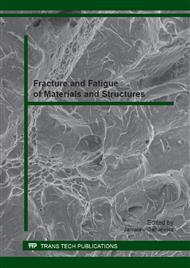p.184
p.190
p.195
p.201
p.207
p.213
p.219
p.225
p.231
Study on Fatigue Cracks in Steel – Concrete Shear Connectors Composite Dowels MCL
Abstract:
In recent years many experimental researches were carried out on steel-concrete composite beams with shear connectors of composite-dowels type. Shear connection is mainly used in bridge construction, where strength and fatigue durability of structure are important issues. Research on fatigue in the Preco-Beam project [1] have confirmed the hypothesis that the initiating and propagating crack in steel connecting beam may lead to the loss of its continuity, resulting in failure or even destruction of superstructure [2,. However, it should be noted that these studies were carried out for a specific type of mechanical connector, called PZ-type (Fig. 1). Within next years different shape was developed (MCL shape), which combines many advantages and eliminates disadvantages of the previous types of shapes [4]. In the study [5] complex fatigue tests of beams (in scale similar to natural) were conducted at the Wrocław University of Technology. The objective of that study was to describe the behavior of MCL-type steel connectors. Two failure mechanisms of steel connectors were presented: so-called tearing of steel flange and pulling out of steel dowel. This paper presents the course and the results of macroscopic and microscopic tests of observed fatigue cracks. For the selected crack a profilogram was prepared, which allowed explaining causes of its initiation and characteristics of its development.
Info:
Periodical:
Pages:
207-212
Citation:
Online since:
January 2014
Authors:
Price:
Сopyright:
© 2014 Trans Tech Publications Ltd. All Rights Reserved
Share:
Citation:


